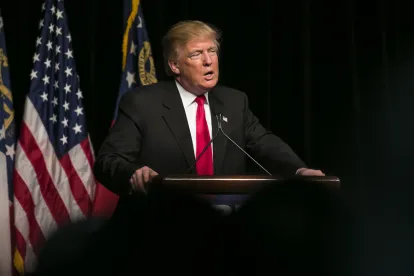On April 18, President Trump signed a new executive order (EO) at a ceremony in Kenosha, Wisconsin. The EO is entitled “Buy American and Hire American” and focuses on these two themes, with the President’s stated goal of ending the “theft of American prosperity” by focusing on American workers and products. While the details of how the new EO will be applied will undoubtedly take months to implement (pending numerous agency-level reviews), companies doing business with the federal government, or with an interest in foreign high-skill workers, should be aware of these new developments so that they can prepare for the adjustments they will need to make in the near future, as the President’s efforts to put American workers first take shape.
Buy American
The “Buy American” portion of the EO sets the already obvious Trump Administration policy to maximize the use of goods, products, and materials produced in the U.S. The stated end goals are to “promote economic and national security and to help stimulate economic growth, create good jobs at decent wages, strengthen our middle class, and support the American manufacturing and defense industrial base.” These kinds of objectives have long been a priority for the federal government dating back to the Great Depression, but the new EO re-emphasizes these objectives, calling particular attention to the various “Buy American” laws that currently govern federal spending.
As an initial matter, there is not one, single “Buy American” statute. There are numerous statutes for numerous agencies that impose unique purchasing requirements for that agency and for specific types of products. Some Buy American requirements merely impose an evaluation preference for domestically manufactured products, while other Buy American requirements require the delivery of products that are wholly (both the product and the component materials) manufactured in the U.S. Some Buy American requirements have numerous exceptions available, while others have very few if any – including exceptions relating to the purchase of commercially-available off-the-shelf products. Some Buy American requirements are expressly waived under international free trade agreements (FTAs), which grant our trading partners some degree of reciprocity in the U.S. and foreign public procurement markets. The EO acknowledges that there are multiple, different statutory requirements, but it nonetheless casts all “Buy American” requirements broadly, demanding that agencies take greater steps to ensure that U.S.-made products (and, in turn, U.S. industry) are given the maximum practicable priority over foreign alternatives.
Beyond setting forth the broad policy announcements described above, the EO does little that immediately affects government contractors. Specifically, the EO includes the following directives:
-
Every agency shall “scrupulously” monitor, enforce, and comply with Buy American laws, to the extent they are applicable (an objective that, frankly, should already be happening under existing laws);
-
Agencies shall minimize the use of Buy American waivers, ensuring that public interest waivers “should be construed to ensure the maximum utilization of goods, products, and materials produced in the United States” and ensuring that agency heads “take appropriate account of whether a significant portion of the cost advantage of a foreign-sourced product is the result of the use of dumped steel, iron, or manufactured goods or the use of injuriously subsidized steel, iron, or manufactured goods”;
-
Within 60 days (by approximately June 19, 2017), the key regulators shall issue guidance (which may well include updates to the regulations) to assist the agencies in better implementing the Administration’s Buy American priorities;
-
Within 150 days (by approximately September 18, 2017):
-
Agencies shall:
-
Assess the ways in which the agencies monitor, enforce, and implement compliance with Buy American requirements;
-
Assess the use of waivers, including the impacts that such waivers may have on domestic jobs and manufacturing; and
-
Develop policies that ensure government procurements and grants maximize the use of materials sourced from or manufactured in the U.S.;
-
-
The Secretary of Commerce and the U.S. Trade Representative shall also assess the impacts of various free trade agreements on the operation of the various Buy American laws (presumably as a lead-in to potential re-negotiation of these international agreements);
-
-
Within 220 days (by November 15, 2017), the key regulators shall submit a report to the President, reporting on some of the various issues identified above, and making recommendations on how to “strengthen implementation of Buy American Laws,” with annual reports recurring through at least 2020.
The practical impact of this new EO remains to be seen, as many of these requirements will need to be implemented through updated regulations and agency memoranda (which are likely to take longer than 60 days to materialize, particularly if the regulations are subject to a notice and comment period under the Administrative Procedure Act). Still, the reality is that nearly all government contracts and grants already have some type of “Buy American” requirement included in the agreement. As such, companies are already “on the hook” for complying with the existing country of origin restrictions, including exceptions available under existing FTAs. The EO contains a provision indicating that it should not be “construed to impair or otherwise affect … existing rights or obligations under international agreements.” As such, until things are actually changed, it does not seem that much has changed. Nonetheless, it seems likely that the new EO will create a fair level of anxiety amongst government purchasing personnel, and many will feel the need to scrutinize more closely the country of origin requirements under existing contracts. Hopefully, cooler heads will prevail and government personnel will understand that until the regulations are actually updated, and until a contract or grant is actually updated to include the new Buy American requirements, nothing has actually changed. For industry, this means that talking through these issues with your customer may be necessary to help everyone understand the difference between the actual, existing Buy American requirements and what people reflexively think they should be (or might be in the future).
Hire American
The “Hire American” portion of the EO sets forth a broad policy to support its theme, but focuses primarily on the H-1B high skilled temporary foreign worker program. This program, which has been in existence since the early 1990s, has been the subject of increasing criticism in recent years, including from the President on the campaign trail. He has promised to significantly reform the program, and this EO begins that process.
The EO first sets forth that it is the Administration’s policy to “rigorously enforce and administer the laws governing entry” of foreign workers into the U.S., citing a statutory provision (8 U.S.C. 1182(a)(5)) that requires, among other things, the Secretary of Labor to certify that there are not sufficient American workers to perform the work that an applicant for admission seeks to perform. This statute actually refers to matters involving sponsorship of permanent residency through labor certification so it remains to be seen how the Administration will apply this to non-immigrant visas without Congressional legislative reform. However, it is nonetheless a clear signal that the Trump Administration intends to ramp up the Department of Labor’s role in regulating, auditing and enforcing this law. The EO goes on to require the Departments of Labor, Justice, Homeland Security and State to propose new rules and guidance to crack down on fraud and abuse in our immigration system in order to protect workers in the U.S. Specifically, it calls on those four departments to develop changes to the H-1B program so that visas are awarded “to the most-skilled or highest-paid” applicants.
Unlike the “Buy American” portion of the EO, the “Hire American” portion does not set a timeline for review and study, but simply directs that the Order be executed “as soon as practicable.” Senior Administration officials have signaled that agencies are ready to move quickly with some of these changes, while others will take time. Some measures, such as stepped-up enforcement by the Department of Labor, could happen within weeks or months, while others, such as changes to the H-1B application process would not take effect before next spring’s H-1B application season, at the earliest.
According to the Government, about 80 percent of H-1B workers are paid less than the relevant median wage in their fields. In order to counteract this alleged undercutting of American workers’ pay, the EO presages changes that Administration officials have described as “a total transformation of the H-1B program.” At the signing ceremony, the President stated that the driving principle behind his initiative is that employers should hire “American workers first.”
The White House has conceded that not all changes it seeks could be accomplished by the Administration alone. It envisions some administrative changes, such as raising visa application fees, raising the wage scale to reduce the undercutting of Americans’ pay levels, and more vigorous enforcement of the rules by the Departments of Labor and Justice. It is also considering changing the lottery system to give foreigners with U.S. master’s degrees a leg up.
In fact, U.S. Citizenship and Immigration Services (USCIS) recently announced that it would view a Level 1 wage for an H-1B position in the IT industry as incompatible with the definition of “specialty occupation.” This alone will have an immediate impact on certain H-1B wages.
By contrast, any changes to the quotas on the issuance of H-1B visas (currently 20,000 exclusively for those with Masters degrees or higher and 65,000 for all others) would have to be implemented by legislation. A number of bills have already been introduced in the 115th Congress to address and reform the H-1B program. Most would either raise the required wage for H-1B recipients or replace the random lottery with a merit-based system, or both. These ideas enjoy bipartisan support.
It is also Congress that defined an H-1B “specialty occupation” as a position requiring the a minimum of a bachelor’s degree and the theoretical and practical application of highly specialized knowledge. 8 USC 1184 (i)(1). Therefore, limiting the scope further to only those with advanced degrees or certain occupations may require legislative reform. However, the executive branch could promulgate new regulations redefining “highly specialized knowledge” to give weight to certain degrees and occupations. USCIS has taken a similar approach in the past with regard to “advanced knowledge” in the context of the L-1B (employee transfer) visa classification.
First, last or in between, American workers and industry could be impacted. Companies should keep a close eye on this developing situation. We will continue to monitor developments at the White House, the agencies and on the Hill, and will update you as appropriate.





 />i
/>i

